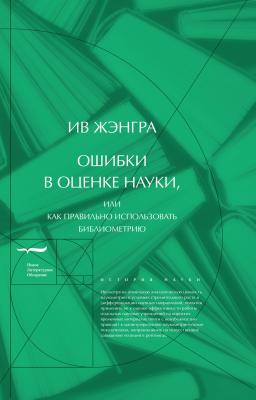ТОП просматриваемых книг сайта:
Ошибки в оценке науки, или как правильно использовать библиометрию. Ив Жэнгра
Читать онлайн.Название Ошибки в оценке науки, или как правильно использовать библиометрию
Год выпуска 2018
isbn 978-5-4448-1005-7
Автор произведения Ив Жэнгра
Издательство НЛО
57
См.: Kevin W. Boyack, Richard Klavans, Katy Börner, “Mapping the backbone of science,” in Scientometrics, 64, 2005, pp. 351–374.
58
См.: Jean Piaget, “Le système et la classification des sciences,” in Jean Piaget (dir.), Logique et connaissance scientifique (Paris: Gallimard, 1967), pp. 1151–1224.
59
См. изображения в: Katy Börner, Atlas of science. Visualizing what we know (Cambridge: MIT Press, 2010); а также на веб-сайте: http://scimaps.org/atlas/maps.
60
Conseil des académies canadiennes [Совет канадских академий], Éclairer les choix en matière de recherche: indicateurs et décisions (Ottawa: Conseil des académies canadiennes, 2012).
61
См.: Vincent Larivière, Éric Archambault, Yves Gingras, “Long-term variations in the aging of scientific literature: from exponential growth to steady-state science (1900–2004),” Journal of the American Society for Information Science and Technology, 59, 2008, pp. 288–296.
62
См.: Matthew L. Wallace, Vincent Larivière, Yves Gingras, “Modeling a century of citation distributions,” in Journal of Informetrics, 3, 2009, pp. 296–303.
63
См.: “Citations track the fate of cold fusion,” in New Scientist, 1713, 21 April 1990.
64
Anthony F. J. van Raan, “Sleeping beauty in science,” in Scientometrics, 59, 2004, pp. 461–466.
65
См.: Y. Gingras, “La carrière des publications d’Ettore Majorana. Une étude bibliométrique,” in Revue de synthèse, 134, 2013, pp. 75–87.
66
Peter A. Lawrence, “The mismeasurement of science,” in Current Biology, 17, 2007, pp. R584–R585.
67
См.: Y. Gingras, “Revisiting the ‘quiet debut’ of the double helix: a bibliometric and methodological note on the ‘impact’ of scientific publications,” in Journal of the History of Biology, 43, 2010, pp. 159–181.
68
См.: Y. Gingras, “The collective construction of scientific memory: the Einstein – Poincaré connection and its discontents, 1905–2005,” in History of Science, 46, mars 2008, pp. 75–114; idem, “The transformation of physics from 1900 to 1945,” in Physics in Perspective, 12, 2010, pp. 248–265.
69
См.: Eugene Garfield, “Random thoughts on citationology. Its theory and practice,” in Scientometrics, 43, 1998, pp. 69–76.
70
См.: Eugene Garfield, “‘Science Citation Index.’ A new dimension in indexing,” in Science, 144, 8 May, 1964, pp. 649–654.
71
См.: Norman Kaplan, “The norms of citation behavior: prolegomena to the footnote,” in American Documentation, 16, 1965, pp. 179–184.
72
Derek de Solla Price, Little Science, Big Science, op. cit., p. 65.
73
Charles Bazerman, Shaping Written Knowledge (Madison: The University of Wisconsin Press, 1988).
74
James E. McClellan III, Specialist Control. The Publications Committee of the Académie Royale des Sciences (Paris), 1700–1793 (Philadelphie: American Philosophical Society, 2003), pp. 33 and 38.
75
См.: Loet Leydesdorff, “Theories of citation?”, in Scientometrics, 43, 1998, pp. 5–25.
76
См.: Blaise Cronin, The Citation Process. The Role and Significance of Citations in Scientific Communication, Londres, Taylor Graham, 1984.
77
См.: G. Nigel Gilbert, “Referencing as persuasion,” in Social Studies of Science, 7, 1977, pp. 113–122.
78
См.: Joseph Bensman, “The aesthetics and politics of footnoting,” in Politics, Culture and Society, 1, 1988, pp. 443–470; в этом длинном эссе нет ни одной ссылки или конкретных данных, а лишь пространная спекуляция на тему прогрессирующей самореферентности и стратегий цитирования.
79
См.: Vincent Larivière, Alesia Zuccala, Éric Archambault, “The declining scientific impact of theses: implications for electronic thesis and dissertation repositories and graduate studies,” in Scientometrics, 74, 2008, pp. 109–121; см. также: Matthew L. Wallace, Vincent Larivière, Yves Gingras, “A small world of citations? The influence of collaboration networks on citation practices,” in PlosOne, 7, 2012, e33339.doi:10.1371/journal.pone.0033339.
80
См.: Susan Bonzi, H. W. Snyder, “Motivations for citation: A comparison of self citations and citations to others,” in Scientometrics, 21, 1991, pp. 245–254; см. также: Béatrice Millard, “Les citations scientifiques: des réseaux de références dans des univers de références. L’exemple d’articles de chimie,” in REDES, Revista hispana para el análisis de redes sociales, 19, 2010, pp. 69–93.
81
См.: ESF [Европейский научный фонд], ESF Survey Analysis Report on Peer Review Practices, ESF, March 2011; www.esf.org/fileadmin/Public_documents/Publications/pr_guide_survey.pdf.
82
Marie Boas Hall, Henry Oldenburg. Shaping the Royal Society (Oxford: Oxford University Press, 2002), p. 84. Первым научным журналом действительно был Journal des savants, издававшийся Дени де Салло с января 1665 года. Однако три месяца спустя его выпуск был запрещен. Потом он был возобновлен, однако его содержание стало весьма разнородным и касалось всех видов деятельности «литературной республики». Это была скорее литературная газета, н

